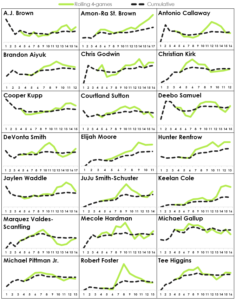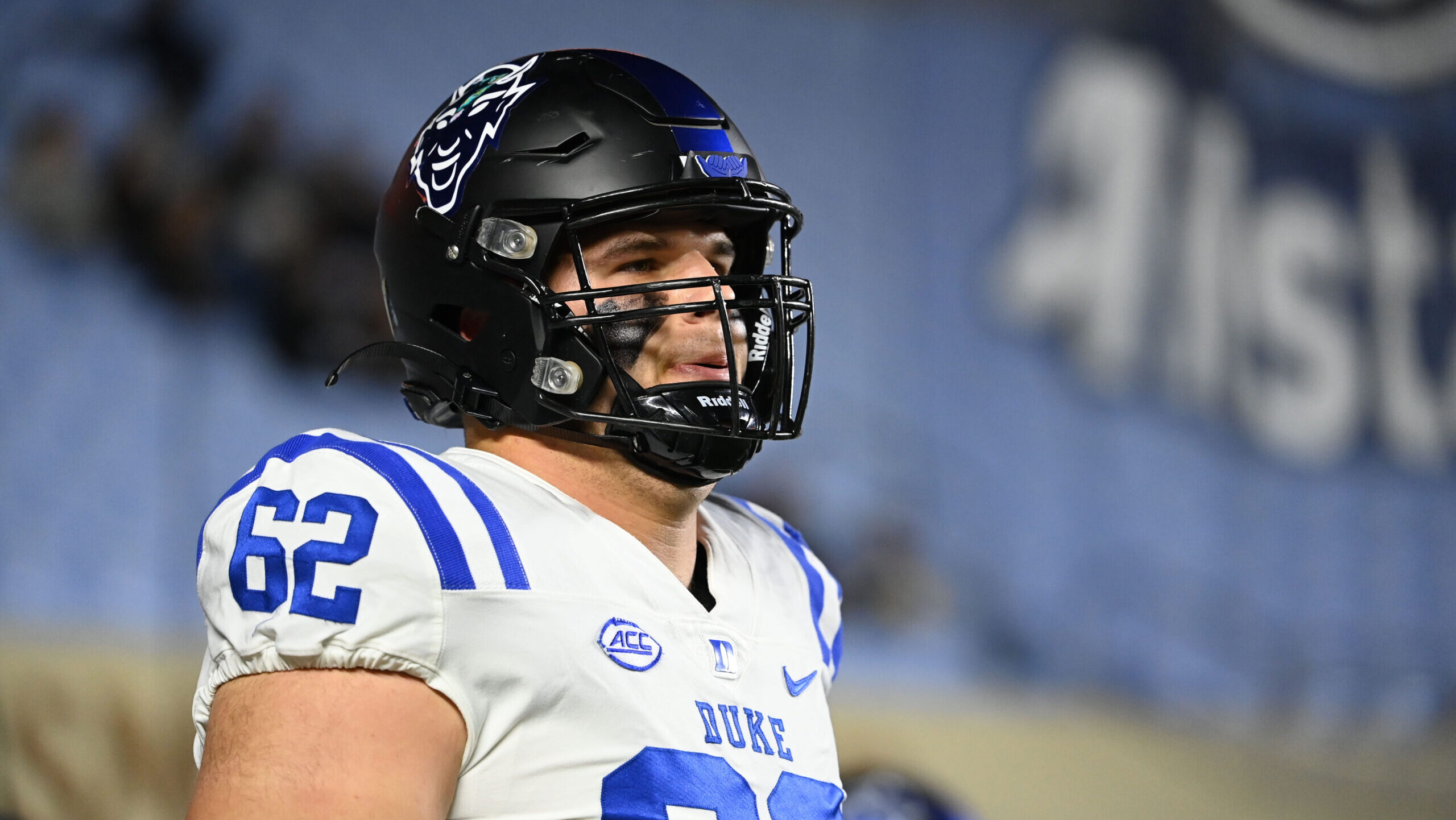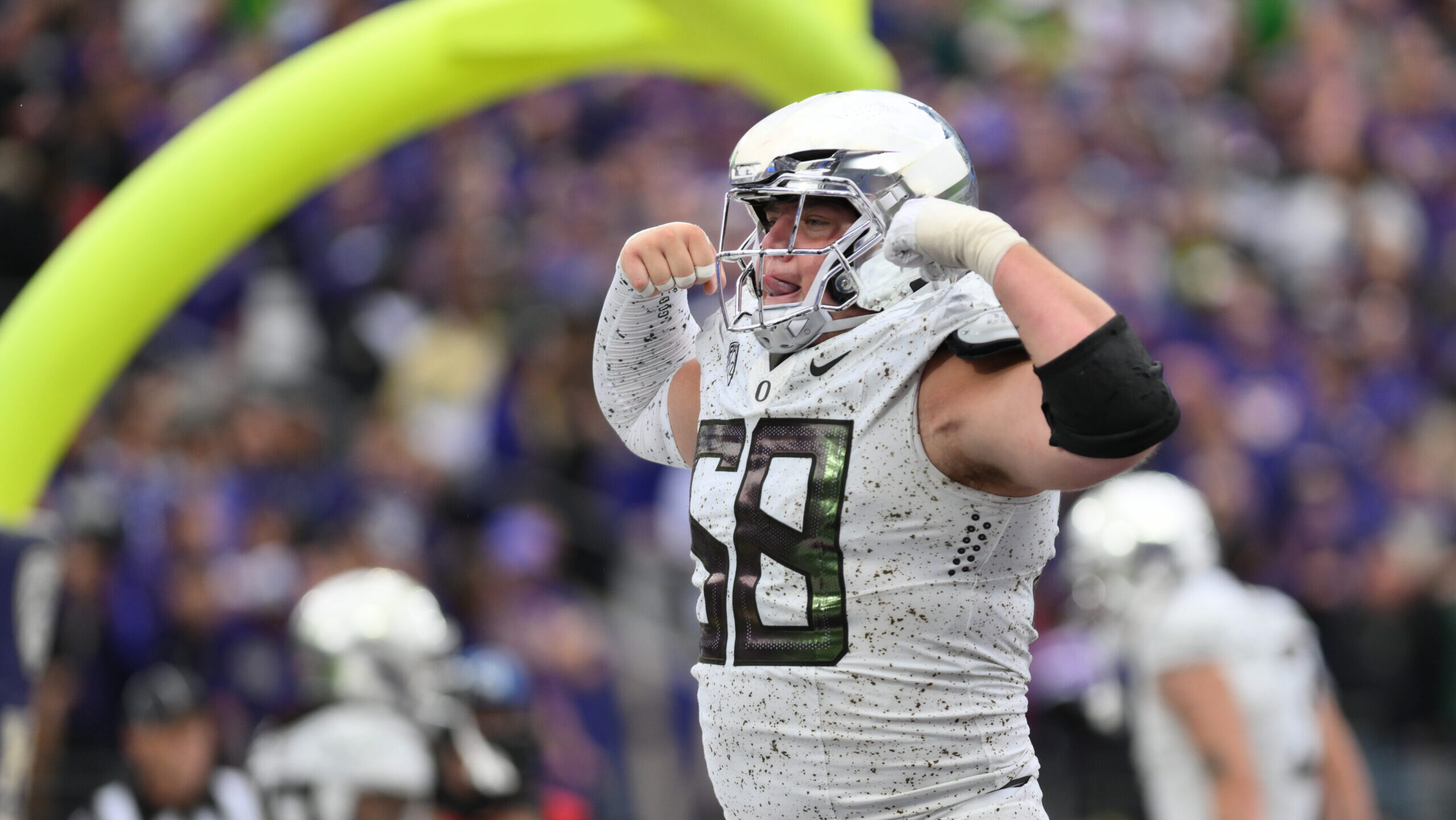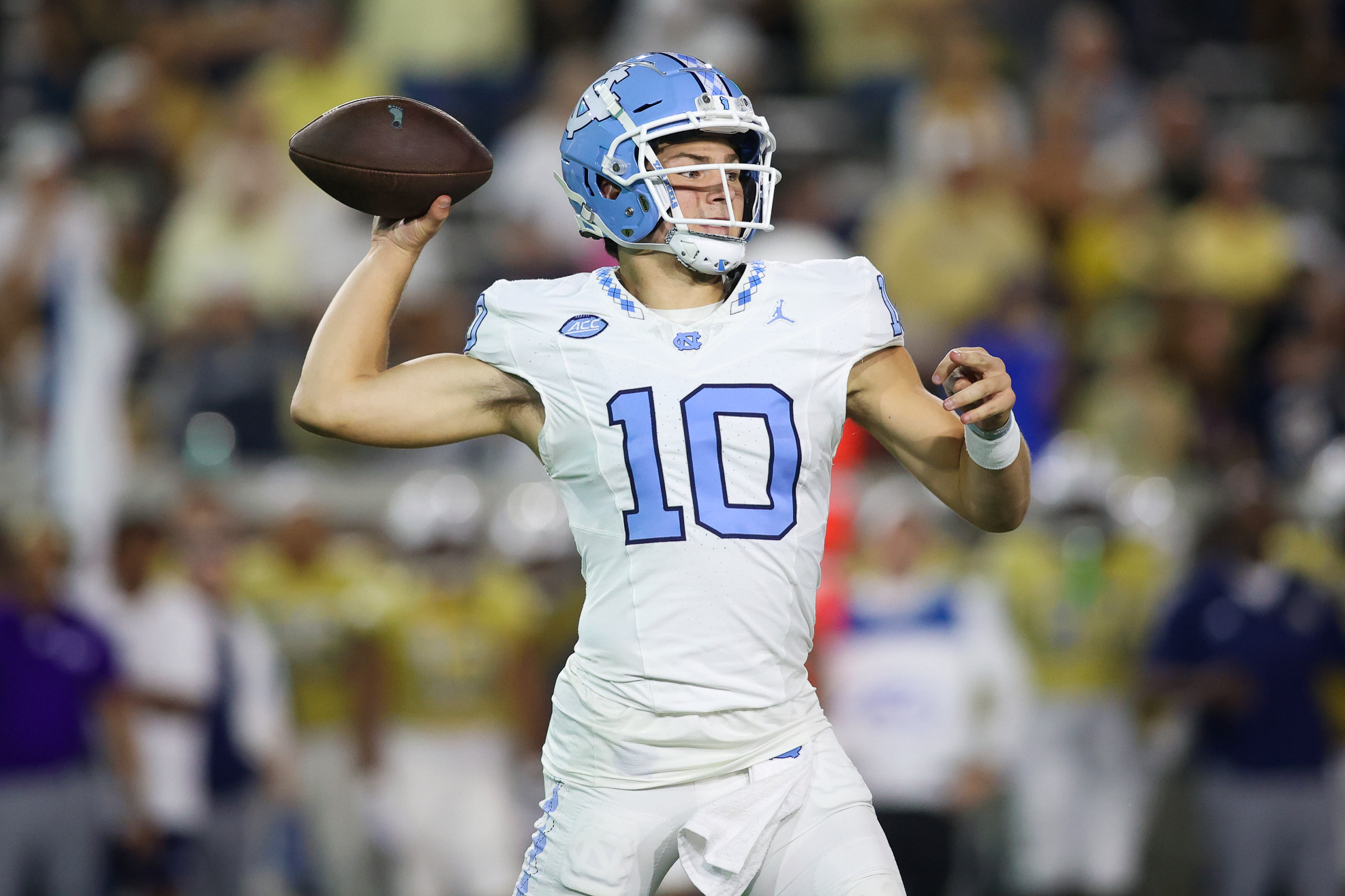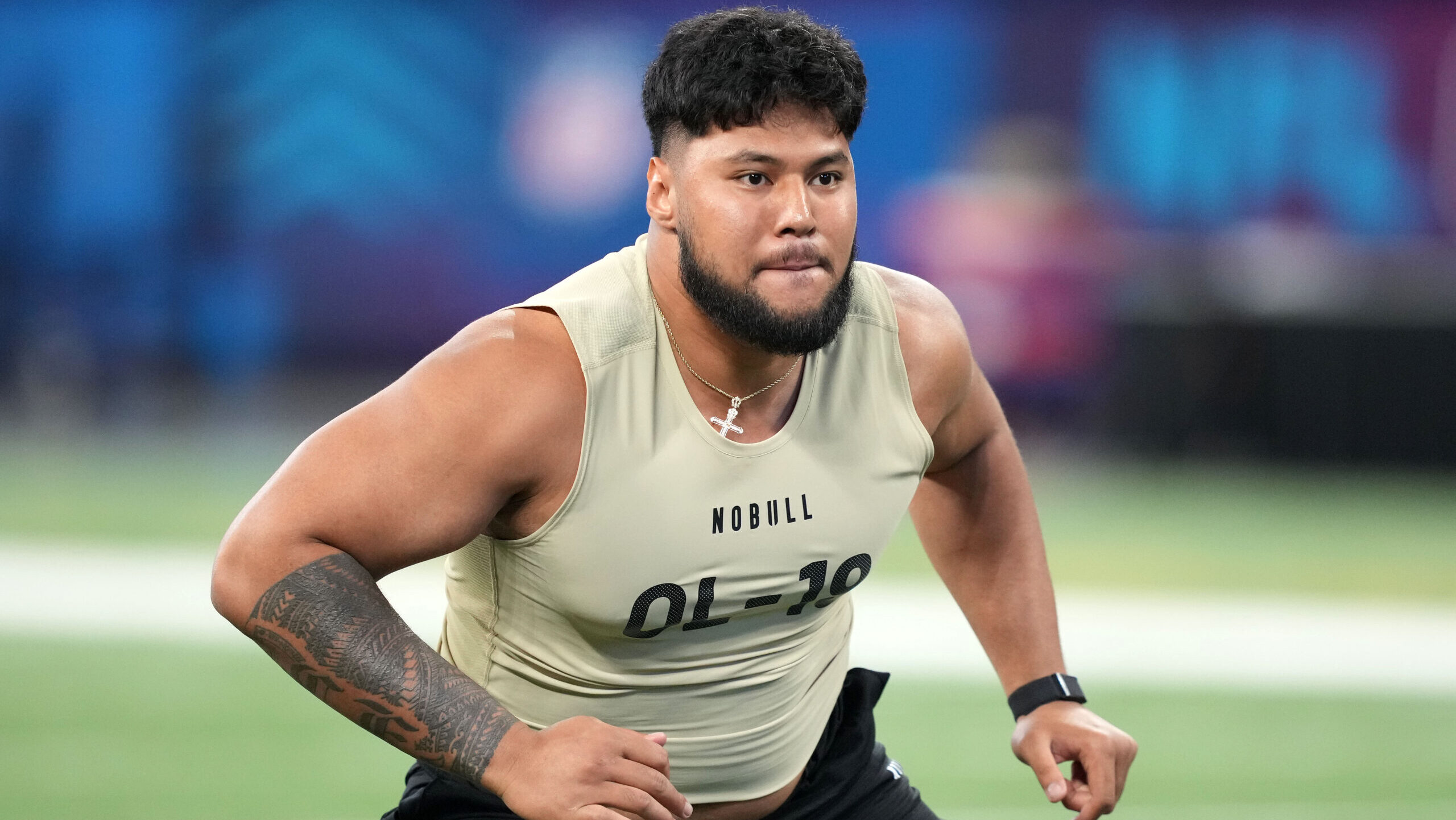Analysis
9/15/22
11 min read
Rookie Wide Receivers: An Analysis of Yards per Route Run and When Rookies Peak
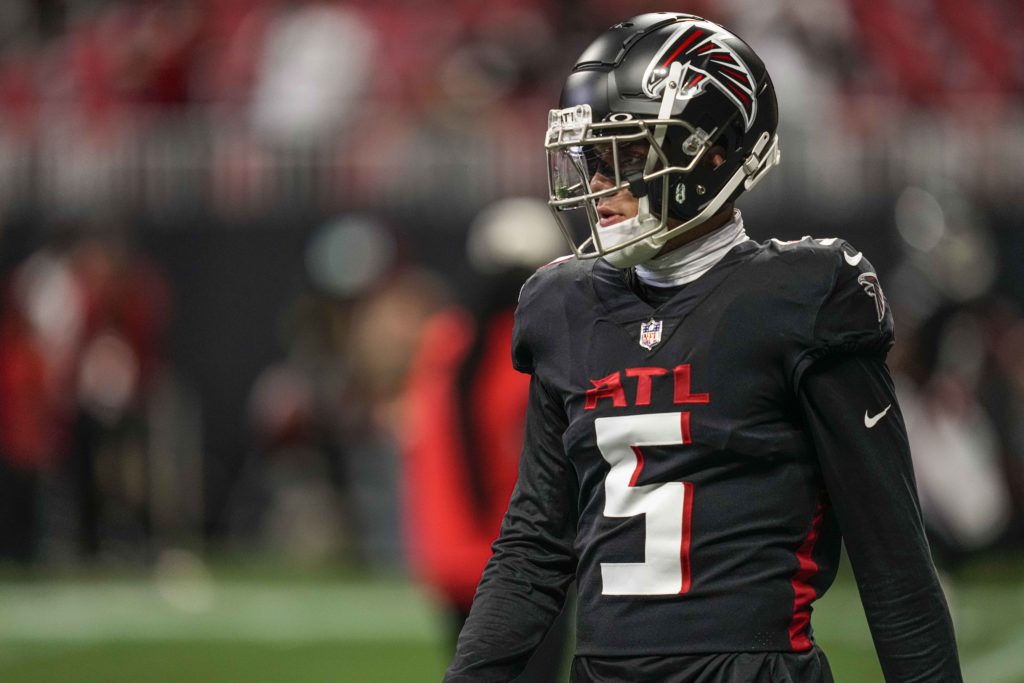
The 2022 draft produced one of the more heralded rookie wide receiver classes the NFL has seen in a long time, and the spotlight remains squarely on this talented group.
No draft in NFL history has had as many wide receivers drafted in the top 20 overall as we saw this year. With six receivers selected in the top 20, fans are clamoring to see an early impact from high draft picks like Drake London (8th pick, ATL), Garrett Wilson (10th, NYJ), and Chris Olave (11th, NO).
Rookie wide receivers have unique obstacles they must overcome as they work hard to combine the elevated mental and physical parts of the NFL game. Every position has a learning curve that a rookie will go through in their first year. At what point in a wide receiver’s rookie season do things begin to click? Some outliers start off on fire, like Ja'Marr Chase last year. Other receivers never click, like Charles Rogers and John Ross. We explore the data to help provide insight on when this year’s top rookies should start to hit their stride.
The Rookie WR Wall
One of the key aspects critical to the success of a rookie receiver is QB-WR chemistry. It takes time and trust from both players to develop that on-field bond. A quarterback needs to know that the receiver is exactly where he should be, when he should be. Running a route one yard short or a fraction of a second late will cause a quarterback to favor other pass-catching options until that trust is earned.
This is something the Bengals considered when they drafted Chase. Chase and Bengals quarterback Joe Burrow already had a connection from their playing days at LSU. With Burrow as his quarterback, Chase set numerous SEC records and won the Biletnikoff Award as college football's top receiver. The two former LSU stars had no problem getting off to a quick start together, as Chase had over 100 yards receiving in his first game in the NFL.
READ MORE: Five Fantasy Takeaways from Week 1
Some wide receivers with a style of play more predicated on physical attributes like size or speed can overcome learning curves sooner. Think of players like Tyreek Hill with his exceptional speed or DK Metcalf using his 6’4’’, 235 lb. frame to dominate smaller defenders. But these examples are rare. A young wide receiver will need to pick up on the mental side of the game quickly, or the game will move too fast around him.
It takes a while for wide receivers to adjust to the press coverage in the NFL, which is used more frequently and effectively than in college. Absorbing the playbook and new terminology is another obstacle in the way of early success. It’s not just on the receiver to learn and adapt; it’s also on the coaching staff. Coaches have a learning curve to understand how to put receivers in the best position to succeed. Practice and preseason alone are not enough. It takes real game experience for everything to start to come together for a rookie WR to reach his potential.
The 2022 Draft Class
After Week 1, as expected, the 2022 rookie class has a mix of positives and negatives. There were no dominant debuts like in 2019, when Marquise Brown had four catches for 147 yards and two touchdowns, and Terry McLaurin went five for 125 and one touchdown. But there were several steady performances. London, the first receiver selected in the draft, led all rookie receivers with 74 yards.
Another first-rounder, Jahan Dotson of the Commanders, caught the game-winning touchdown with less than two minutes left in Washington's game, his second touchdown of the game. Conversely, a disappointing result came from George Pickens. He came in with high expectations after a hot preseason. But Pickens recorded only one catch for three yards in Pittsburgh’s exciting overtime win over Cincinnati. Here are the rest of the rookie WR statistics after the first game of the season:
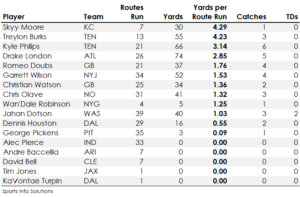
When Should We Expect Wide Receivers to Hit Their Stride in Their Rookie Season?
To understand the arc of a rookie wide receiver’s season, we examined every game of every rookie wide receiver who gained 500+ yards receiving in their first year from 2017-2021 (N=37). Wide receivers aren’t expected to reach their career peak until their fourth or fifth year, but we explored the numbers to determine when their efficiency increases within their first year. Although focusing on 500+ yard receivers may lead to some selection bias, the goal is to measure those who played a complete season, did not get injured, and were not a clear bust. Busts, injuries, and bad luck will all happen. Nevertheless, our goal is to understand when and to what extent WR production will begin to rise for those players who contribute for most of the season.
The metric we focused on is Yards per Route Run (total yards receiving divided by the number of routes run) provided by Sports Info Solutions. This great metric can tell us how frequently players are getting open, earning targets, and making the best of those targets.
The chart below shows the median cumulative Yards per Route Run across all thirty-seven rookie WRs in our five-year sample size. The cumulative focus shows their year-to-date YPRR through each game, which is why the trend becomes less volatile later in the season. We used median over mean to prevent extreme outliers from having a disproportionate impact on the data, for example, Marquise Brown’s 18.4 YPRR in his first game (147 yards on eight routes). Note: game 17 is not included because the sample size is too small to draw a meaningful conclusion.
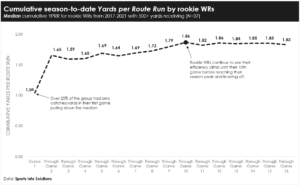
The Most Likely Scenario for Rookie Wide Receivers: Peaking in Week 10
Based on the median of the receivers in our study, a rookie WR season can be segmented into four parts.
- Their first game should be underwhelming on average. Examples of low YPRR in their first career game: Calvin Ridley with 0 yards on 36 routes, Elijah Moore with -3 yards on 35 routes run, and Mecole Hardman with 0 yards on 25 routes run.
- Game 1 is followed by a big leap in game 2, beginning a five-week plateau. All three players above followed up their 0.0 YPRR with numbers at or above league average, a pattern not exclusive to these three players.
- Rookie receivers begin to accelerate around their seventh game with steady week-to-week incremental improvements, until peaking and leveling off by their tenth game.
- The season finishes with a new plateau, about a ten percent improvement on YPRR over their early season plateau.
About 60% of the rookie wide receivers peaked in mid to late season. You can see this pattern throughout the rookie years of many of today’s young stars shown in the charts below. The charts also highlight the frequency of zero YPRR in a player's first game (usually with low route run volume as well).
In addition to the player's cumulative YPRR, the charts below show a rolling four-week YPRR to illustrate the ebbs and flows of the player's production throughout the season. Note: the charts use varying Y-axis scales (vertical axis) to better illustrate the player’s trend; the trend is the takeaway, not precision. The X-axis (horizontal axis) also differs from player to player based on the number of games each played in their rookie year.
Starting off Hot
Although most receivers start off slow, a few rookie WRs enjoyed a big first game. But then they came back down to earth over the next few games. While rookies are learning the game, opponents also learn the new player’s tendencies. Once their first real game is in the books, it’s the first time that opponents have regular-season film on how the player is being used. This may be, in part, what caused the list of rookies below to follow up their exceptional first game with average or below-average efficiency numbers for a stretch.
- A.J. Brown with 100 yards on 17 routes (5.88 YPRR) in game 1, followed by 0.63 YPRR over the next two games
- Cooper Kupp with 76 yards on 21 routes run (3.62) in game 1, followed by 1.42 over the next two games.
- Darius Slayton with 82 yards on 24 routes run (3.42) in game 1, followed by 1.12 over the next four games.
- DeVonta Smith with 71 yards on 33 routes run (2.15) in game 1, followed by 0.64 over the next two games.
- DK Metcalf with 89 yards on 21 routes run (4.24) in game 1, followed by 1.26 over the next three games.
- Marquise Brown with 147 yards on 8 routes run (18.38) in game 1, followed by 1.32 over the next four games.
- Terry McLaurin with 125 yards on 38 routes run (3.29) in game 1, followed by 1.76 over the next three games.
Strong First Half, Followed by Steady Declines
A few scenarios that didn’t follow the conventional pattern were the rookie seasons by Ja’Marr Chase and Justin Jefferson. These two receivers ended with the second-and third-most yards receiving by a rookie in NFL history. Both WRs peaked earlier than most and then experienced periods of prolonged steady declines in YPRR relative to their early season rate.
Ja'Marr Chase
Chase finished 2021 with 1,455 yards receiving, the second-highest rookie season in history. Chase finished eighth overall in Yards per Route Run (min 50 targets) with 2.6. His 2.6 YPRR led all rookie pass-catchers, with Kadarius Toney coming in at second with 2.2 YPRR. Unlike most WRs, he started off quick with 3.6 YPRR seven games into the season, behind only Cooper Kupp at the time (min. 50 target pace). A mid-season slide beginning in Week 8 was likely caused by opposing defenses starting to figure out how best to cover Chase, as he noted the challenges he faced reacting to those defensive adjustments. Chase recorded only the 89th-ranked YPRR in the league (1.3) from Week 8 to Week 14. Finally, Chase exploded out of that mid-season slide by accumulating 389 yards on 89 routes in his 15th and 16th games.
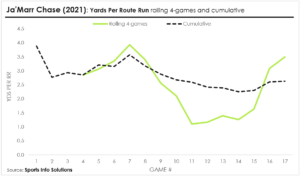
Justin Jefferson
In 2020, Jefferson recorded the third-most yards receiving for a rookie in NFL history with 1,400. Like many rookies, Jefferson's volume wasn’t there to start the season. In his first four games, he averaged only 23 routes run per game, but he amassed 348 yards for the second-best Yards per Route Run (3.9) in the league during the first quarter of the season. His 3.9 through Week 4 would end up as his cumulative peak for the year. He continued to put up relatively high-efficiency numbers through Week 10. But from game 11 to the end of the season, his efficiency numbers began to decline.
It wasn’t noticeable in his box score stats as he averaged 92 yards and seven receptions per game. But he also led the league with 254 routes run during this time, a per-game increase of 56% compared to his first ten games. His Yards per Route Run dropped to 2.2 over his last six games, only good enough for 28th in the league during that period. The 2.2 YPRR appears low relative to the historic season he put together, but his worst stretch of efficiency still led all rookie pass catchers from game 11 to the end of the year.
However, his stretch of games with a declining YPRR is an excellent example of box score and volume metrics masking potential regression in a player’s game. Whatever, “slide” in YPRR he may have experienced quickly resolved, as he finished his second season in 2021 with the fifth-highest Yards per Route Run of 2.7.
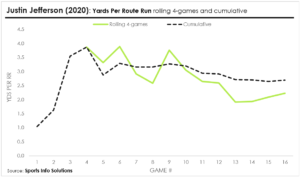
Conclusion
Not all players will follow the traditional Year 1 arc shown in our research. Some players will flame out and never produce; others will peak later or earlier than the data suggests. But the historical trend is a good indicator of what we can expect most players to follow. We likely won’t see the best out of this year’s rookie class over the season's first quarter. Still, our data suggest that barring injury, this year's highly-touted rookie class will begin a steady climb starting now, and reach its peak in mid-November with plenty of season left to play.
WATCH MORE: Josh Fewster's Fantasy Rookie on the Rise

